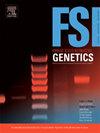Development of a multiplex recombinase amplification assay for the rapid and concurrent detection of human DNA and sex identification
IF 3.1
2区 医学
Q2 GENETICS & HEREDITY
引用次数: 0
Abstract
In forensic practice, it is essential to identify human DNA and determine the sex of individuals from biological samples collected at crime scenes. Currently, the common detection methods mainly focus on targeted DNA analysis based on PCR technology, which is time-consuming and relies on laboratory equipment. In recent years, recombinase polymerase amplification (RPA), as one of ubiquitous isothermal amplification technology, has gained popularity across various diagnostic fields due to its advantages of rapid processing and minimal temperature control requirements. This study has developed a multiplex RPA assay suitable for human and sex components identification. The assay has good sensitivity (as low as 25 pg) and strong tolerance to inhibitors (in the presence of 200 ng/μL humic acid, 400 ng/μL tannic acid, and 8000 ng/μL collagen). Furthermore, we combined the alkaline lysis and RPA detection to construct a rapid detection scheme, which can shorten detection time to half an hour. We also conducted a preliminary exploration of the visualization scheme for the constructed RPA assay. The above research demonstrates simultaneous and rapid detection of human and sex components, offering an accurate and sensitive detection scheme.
开发一种多重重组酶扩增试验,用于快速和同步检测人类DNA和性别鉴定
在法医实践中,从犯罪现场收集的生物样本中识别人类DNA和确定个体性别至关重要。目前,常见的检测方法主要是基于PCR技术的靶向DNA分析,耗时长且依赖于实验室设备。近年来,重组酶聚合酶扩增(recombinase polymerase amplification, RPA)作为一种普遍存在的等温扩增技术,因其处理速度快、温度控制要求低等优点,在各个诊断领域得到了广泛的应用。本研究开发了一种适用于人类和性别成分鉴定的多重RPA测定方法。该方法具有良好的灵敏度(低至25 pg)和对抑制剂(存在200 ng/μL腐植酸,400 ng/μL单宁酸和8000 ng/μL胶原)的强耐受性。此外,我们将碱性裂解和RPA检测相结合,构建了一种快速检测方案,将检测时间缩短到半小时。我们还对构建的RPA实验的可视化方案进行了初步探索。上述研究展示了同时快速检测人类和性别成分,提供了一个准确和敏感的检测方案。
本文章由计算机程序翻译,如有差异,请以英文原文为准。
求助全文
约1分钟内获得全文
求助全文
来源期刊
CiteScore
7.50
自引率
32.30%
发文量
132
审稿时长
11.3 weeks
期刊介绍:
Forensic Science International: Genetics is the premier journal in the field of Forensic Genetics. This branch of Forensic Science can be defined as the application of genetics to human and non-human material (in the sense of a science with the purpose of studying inherited characteristics for the analysis of inter- and intra-specific variations in populations) for the resolution of legal conflicts.
The scope of the journal includes:
Forensic applications of human polymorphism.
Testing of paternity and other family relationships, immigration cases, typing of biological stains and tissues from criminal casework, identification of human remains by DNA testing methodologies.
Description of human polymorphisms of forensic interest, with special interest in DNA polymorphisms.
Autosomal DNA polymorphisms, mini- and microsatellites (or short tandem repeats, STRs), single nucleotide polymorphisms (SNPs), X and Y chromosome polymorphisms, mtDNA polymorphisms, and any other type of DNA variation with potential forensic applications.
Non-human DNA polymorphisms for crime scene investigation.
Population genetics of human polymorphisms of forensic interest.
Population data, especially from DNA polymorphisms of interest for the solution of forensic problems.
DNA typing methodologies and strategies.
Biostatistical methods in forensic genetics.
Evaluation of DNA evidence in forensic problems (such as paternity or immigration cases, criminal casework, identification), classical and new statistical approaches.
Standards in forensic genetics.
Recommendations of regulatory bodies concerning methods, markers, interpretation or strategies or proposals for procedural or technical standards.
Quality control.
Quality control and quality assurance strategies, proficiency testing for DNA typing methodologies.
Criminal DNA databases.
Technical, legal and statistical issues.
General ethical and legal issues related to forensic genetics.

 求助内容:
求助内容: 应助结果提醒方式:
应助结果提醒方式:


